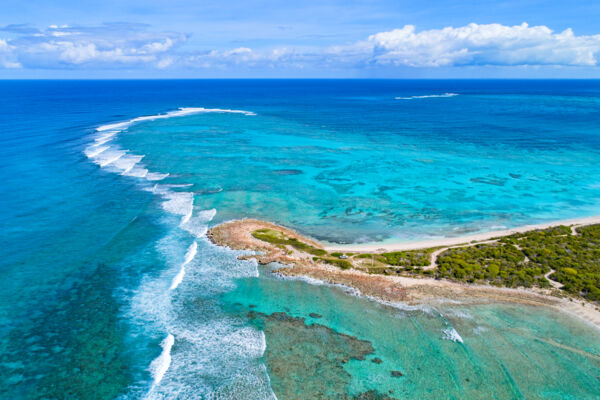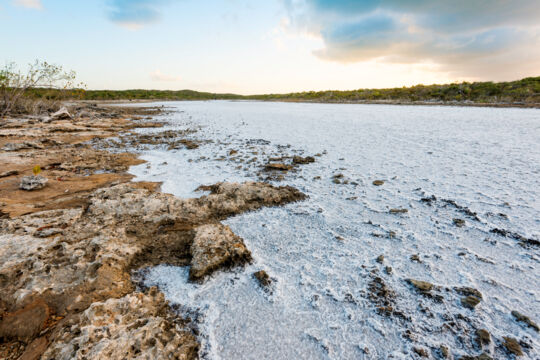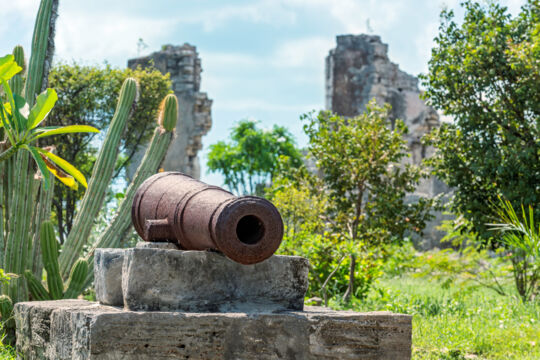Exploring Providenciales
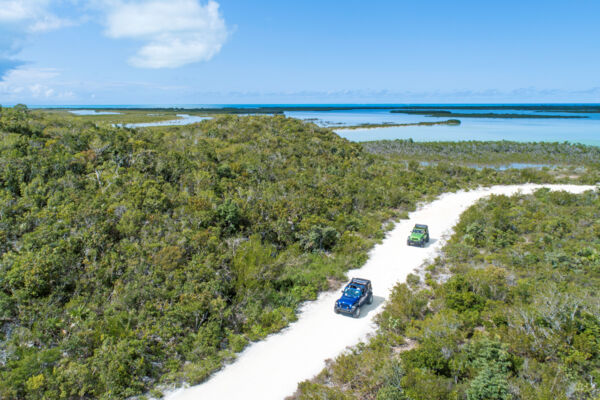
It's highly recommended that you rent a vehicle for at least part of your stay on Providenciales. Taxis can be quite expensive, and there are so many great beaches and sites to visit.
Providenciales isn’t a very large island, at only 15 miles (24 km) across its longest dimension, so navigation isn’t difficult.
One of the highlights of Providenciales is the many great beaches to discover. After visiting the popular beaches, such as world-famous Grace Bay Beach and the Bight Beach, consider venturing to some of the island’s hidden sites, such as the lesser-visited yet amazing Turtle Tail Beach, Babalua Beach, and Malcolm’s Road Beach. Many of the beautiful coasts are secluded, and a rental car is the most convenient way to get to access them.
For guided tours of Providenciales, see Island Tours & Excursions.
Scenic Drives
Providenciales has experienced quite a bit of unsightly development over the last two decades, yet there are still several beautiful scenic routes to enjoy.
Chalk Sound Drive
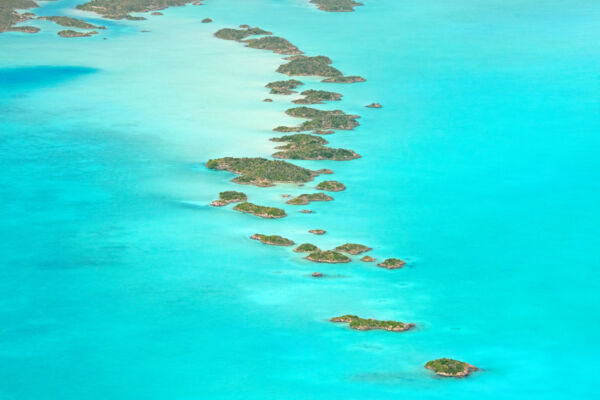
This paved and winding road follows the south side of the incredibly turquoise Chalk Sound National Park. There are rugged little limestone cays, luxury villas, and vibrant water here, making Chalk Sound one of the top sights to see in the Turks and Caicos.
While in Chalk Sound, you’ll also want to stop at Sapodilla Hill for the views and the picturesque Sapodilla Bay and Taylor Bay beaches.
The vegetation in the area is also unique. Much of the terrain is weathered limestone, and the stunted and salt-resistant thatch palms, joewood trees, sea grapes, and sword bushes can look rather like traditional bonsai trees.
When venturing into the wild at Chalk Sound, take care to avoid the poisonous coral sumac tree, which is very common in the area.
Venetian Road and Turtle Tail
Venetian Road off of central Leeward Highway offers another scenic, breezy drive. This 4.7-mile (7.6 km) unpaved road travels along the banks of Turtle Lake, Flamingo Lake, and Juba Point Salina, and ends at the eastern point of the Turtle Tail peninsula.
Around Flamingo Lake, Venetian Road turns into Turtle Tail Drive. The view from 75-foot-tall (23 m) Bristol Hill, near the end of Turtle Tail Drive, offers breathtaking vistas over the Caicos Banks and the inland marine ponds.
The Blue Hills Coastal Road
This beachfront road fronts Blue Hills, the oldest settlement on Providenciales. You’ll see coconut palms and small churches and witness a quaint Caribbean vibe.
A few popular restaurants can be found on this road, but there’s no particular main attraction.
West Harbour Bluff
For the adventurous, the long and unpaved drive out to West Harbour Bluff is quite striking. After traveling through the remote hills south of Blue Hills, the road continues through 3.7 miles (6 km) of isolated western Chalk Sound and Frenchman’s Creek wetlands. You’ll see saline tundra, mangrove channels, natural salt flats, and straggling cotton plants from bygone times.
This road ends at the beach and high peninsula of the scenic West Harbour Bluff Beach.
The interior hilly parts of this road can be quite bad, so you’ll want to have a high-clearance vehicle.
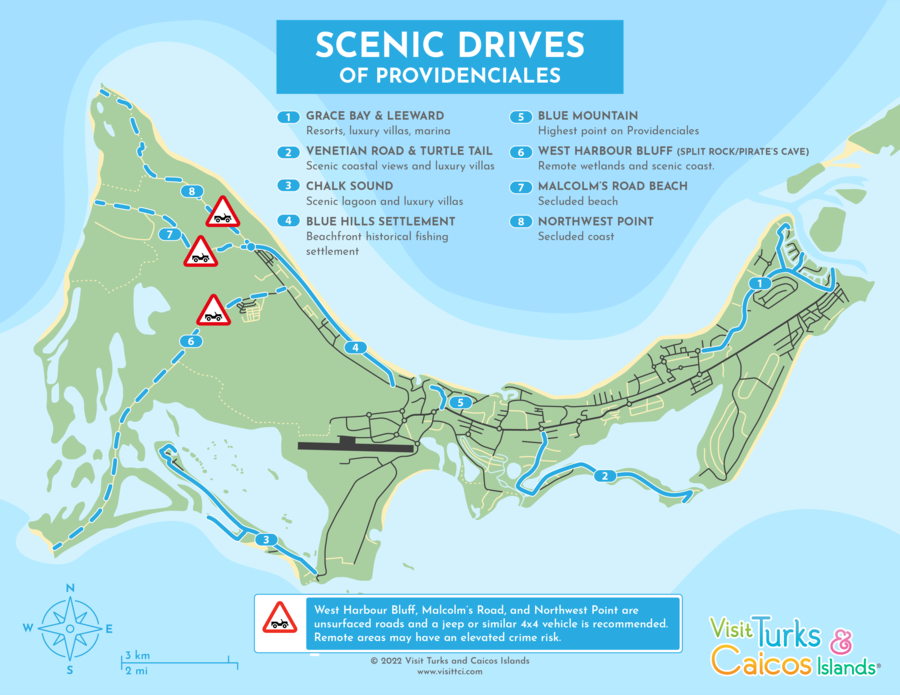
Sights and Attractions
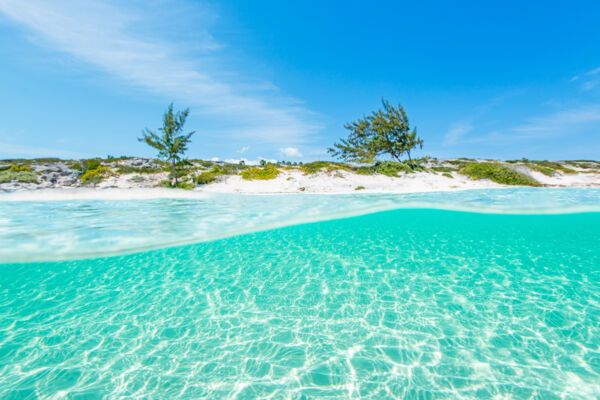
There are many beautiful beaches on Providenciales waiting to be discovered, several of which are rarely visited.
Cheshire Hall Plantation is the primary historical attraction on Providenciales. The ruins of this late 1700s cotton plantation offer an insight into the island's colonial history.
The Hole, a natural limestone sinkhole, is found in Long Bay. Over 60 feet (18 m) deep, it features brackish water at the bottom.
You can find a satellite location of the Turks and Caicos National Museum in Grace Bay. The main museum is located on the island of Grand Turk, yet the small Providenciales branch contains interesting artifacts nonetheless. Funds are being raised to build a much-needed extensive museum complex on Providenciales.
The National Environmental Centre on Providenciales is another great stop. The exhibits here aren’t extensive, but it’s worth a quick visit.
Hiking
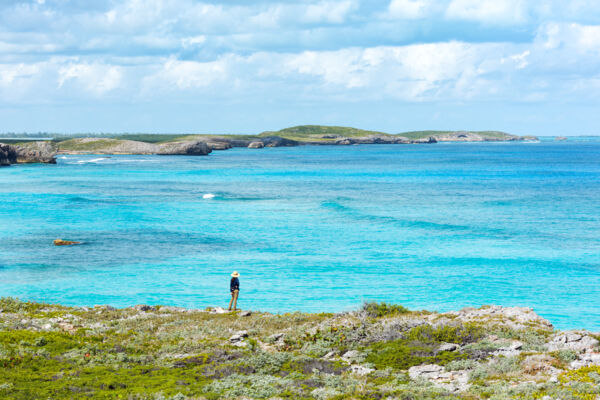
Providenciales unfortunately doesn’t have many dedicated nature or hiking trails, with the exception of Bird Rock Trail on the southeastern point of the island. Hikers should consider visiting North Caicos and Middle Caicos, which are two of the larger islands and that are connected by a road causeway. Both islands offer exceptional outdoor attractions, and the Crossing Place Trail on Middle Caicos navigates one of the most scenic coastlines in the Turks and Caicos.
Bird Rock Trail is the only actual developed hiking path on Providenciales, and features a semi-manicured trail that leads out onto beautiful views of the ocean and Bird Rock.
The remote western side of Providenciales offers spectacular coastal and wetland landscapes, but access can be difficult and trails simply don’t exist. These locations will likely appeal to those who don’t mind venturing off the beaten path.
One such area is the coast south of Northwest Point National Park. The secluded beaches, crystal water, wetland ponds, and low ironshore cliffs are quite beautiful.
Another isolated yet stunning site is the Frenchman's Creek and Pigeon Pond Nature Reserve. The largest protected area on Providenciales, this region is home to red mangrove-lined waterways, tidal flats, and beautiful interior wetlands, all of which teem with wildlife.
Jeep Rentals




